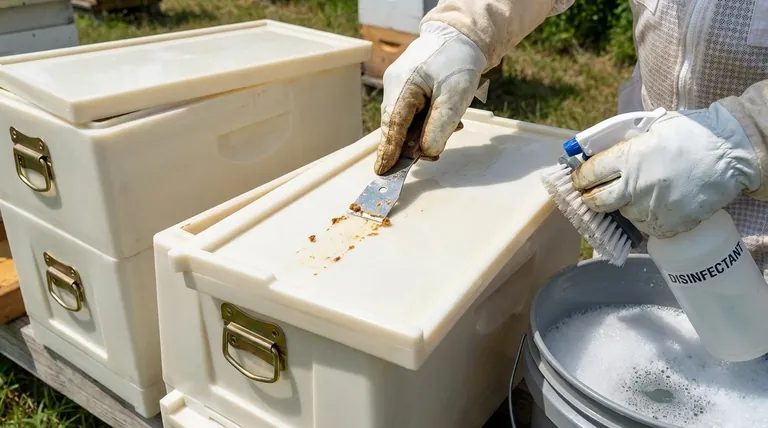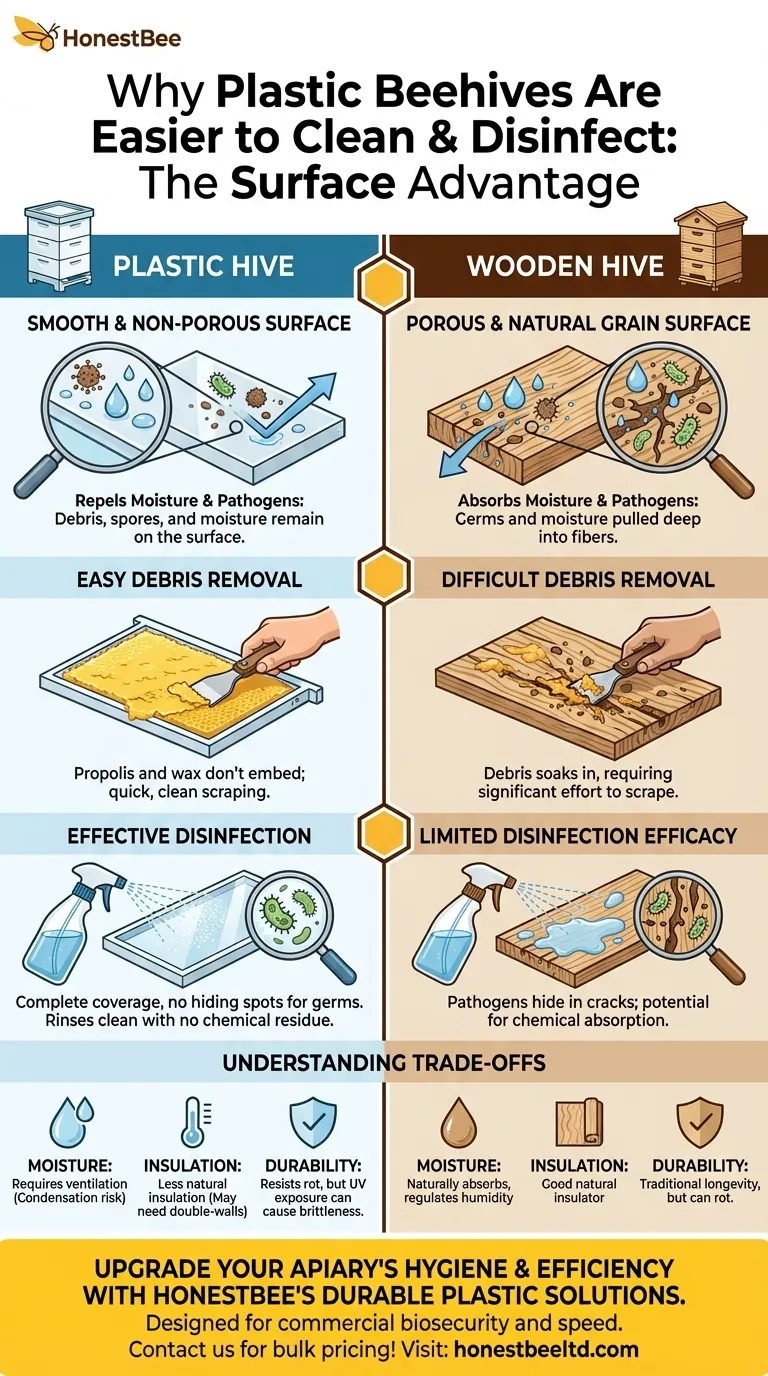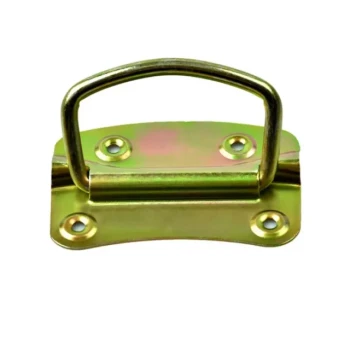Ultimately, it comes down to surface texture. Plastic beehives are easier to clean and disinfect because their surfaces are smooth and non-porous. Unlike wood, which has natural grains, cracks, and pores, plastic presents a uniform surface that prevents debris and pathogens from becoming deeply embedded, making them simpler to scrape, wash, and sanitize effectively.
The core difference is that wood absorbs, while plastic repels. This fundamental property makes plastic hives faster to clean and allows disinfectants to work more efficiently on the surface, directly impacting disease prevention and hive management.

The Core Advantage: A Non-Porous Surface
The material science of plastic versus wood is the foundation of its ease of maintenance. A non-porous, or impervious, surface creates a less hospitable environment for pests and pathogens.
Resisting Absorption
Wood is naturally porous. It absorbs moisture, honey, and microscopic pathogens, pulling them deep into its fibers where they can be difficult or impossible to remove.
Plastic, by contrast, is non-porous. Pathogens, spores (like American Foulbrood), and moisture remain on the surface, meaning they can be washed or wiped away completely without penetrating the material.
Simplifying Debris Removal
Bees use propolis (a sticky resin) to seal cracks and beeswax to build comb. On a wooden surface, these substances get pushed into the grain and any small imperfections, requiring significant effort to scrape clean.
The smooth surface of plastic prevents this. Propolis and wax adhere only to the surface, allowing a beekeeper to remove them cleanly and quickly with a standard hive tool.
Maximizing Disinfection Efficacy
A clean surface is only the first step; effective disinfection is critical for preventing the spread of bee diseases. Here again, the material's properties play a decisive role.
Achieving Complete Coverage
When you spray or soak hive components, a smooth plastic surface allows the disinfectant to coat every part of the equipment evenly. There are no microscopic crevices or pores for germs and parasites to hide in.
This uniform coverage ensures the disinfectant makes direct contact with any remaining pathogens, leading to a more reliable and thorough sanitization process.
Preventing Chemical Residue
Because wood absorbs liquids, it can also absorb cleaning agents and disinfectants. This creates a risk that these chemicals could leach back out into the hive environment over time.
Plastic can be rinsed clean much more thoroughly. Once the disinfection process is complete, a simple rinse removes virtually all residual chemicals from the non-absorbent surface.
Understanding the Trade-offs
While easier to clean, plastic hives are not without their considerations. Objectivity requires acknowledging the potential downsides.
Moisture and Condensation
Wood can absorb a certain amount of moisture, helping to regulate the hive's internal humidity. Plastic does not "breathe," which can lead to condensation buildup on the inner walls and lid, especially in colder climates. Proper ventilation is essential to manage this.
Thermal Insulation
Wood is a natural insulator. Standard plastic hives, particularly those with thin walls, can offer less thermal protection, getting hotter in the summer and colder in the winter. Some manufacturers mitigate this with double-walled or foam-filled designs.
Durability and Bee Preference
While durable, some plastics can become brittle over time with prolonged UV exposure. Furthermore, some beekeepers observe that bees are slower to draw comb on new plastic frames compared to wax-coated wooden frames, preferring the natural texture.
Making the Right Choice for Your Goal
The best hive material depends entirely on your beekeeping philosophy and operational goals.
- If your primary focus is biosecurity and operational efficiency: Plastic is the superior choice due to its speed of cleaning and effectiveness in disease control, especially for commercial operations.
- If your primary focus is natural materials and hive breathability: Wood remains the traditional and effective choice, though it requires more labor for deep cleaning and maintenance.
- If your primary focus is a balance of convenience and natural beekeeping: Consider using wooden boxes with plastic frames and foundation, which combines the benefits of a breathable hive body with easier frame management.
Choosing the right equipment is about understanding the principles behind it and aligning those with your management style.
Summary Table:
| Feature | Plastic Hive | Wooden Hive |
|---|---|---|
| Surface Texture | Smooth, non-porous | Porous, with natural grain |
| Debris Removal | Easy to scrape; propolis/wax don't embed | Difficult; debris soaks into wood fibers |
| Disinfection Efficacy | High; disinfectants coat evenly, no hiding spots | Lower; pathogens can hide in pores |
| Moisture Management | Can lead to condensation; requires ventilation | Naturally absorbs moisture; helps regulate humidity |
| Durability | Resists rot; may become brittle with UV exposure | Can rot if not maintained; traditional longevity |
Upgrade your apiary's hygiene and efficiency with HONESTBEE's durable plastic beehive solutions. Designed for commercial beekeepers and distributors who prioritize biosecurity and operational speed, our wholesale-focused plastic equipment ensures faster cleaning, more effective disinfection, and superior disease management. Contact our team today to discuss bulk pricing and how our supplies can strengthen your beekeeping operation.
Visual Guide

Related Products
- Professional Grade Foldable Beehive Handles
- Professional Drop-Style Hive Handles for Beekeeping
- Professional Galvanized Hive Strap with Secure Locking Buckle for Beekeeping
- HONESTBEE Professional Hive Top Bee Feeder Feeding Solution
- Black Plastic Beetle Barn Hive Beetle Trap for Beehives
People Also Ask
- When should the first inspection of a new hive be conducted? Ensure a Strong Start for Your Colony
- What month do honey bees come out? Understand Their Spring Emergence & Activity Cycle
- Why is it important to understand honey bee behavior when handling them? Master Safe & Effective Beekeeping
- What are some potential benefits of drones in a bee colony? Enhancing Hive Health and Productivity
- What is a common hive setup in warmer regions? A Simple, Effective Guide for Healthy Bees



















